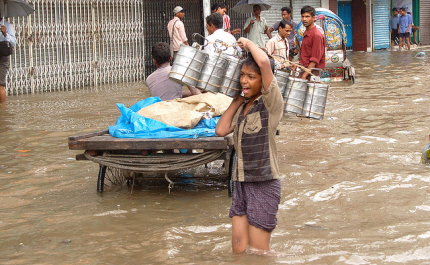Two other countries in South Asia are in the extreme risk category, India being found the 20th most vulnerable among the 193 countries studied, and Pakistan 24th. Of the countries dependent on the Hindu Kush Himalayas, China – at 61st position – is in the high risk category too.
Maplecroft has also calculated climate risks that will be faced by 50 cities around the world over the next 30 years. The study found five cities at “extreme risk”, of which three are in South Asia – Dhaka (in Bangladesh), Mumbai and Kolkata (both in India).
The study also found that Shenzhen and the Pearl River Delta, “which encompasses the cities of Guangzhou, Dongguan and Foshan and make up China’s manufacturing heartland, are among the most exposed to physical risks from extreme climate-related events,” according to a Maplecroft spokesperson.
The company has been studying climate impact risks since 2008. This year they found that by 2025, 31% of global economic output will be based in countries facing high or extreme risks. This is a 50% increase on current levels and more than double since the study began six year ago.
Maplecroft’s 2013 Climate Change and Environmental Risk Atlas shows that 67 countries with an estimated combined output of $44 trillion, will be among the countries under increasing threat from the physical impacts of more frequent and extreme climate-related events, such as severe storms, flooding or drought.
The CCVI shows that economic impacts will be worst in Bangladesh, Guinea-Bissau, Sierra Leone, Haiti, South Sudan, Nigeria, Democratic Republic of Congo, Cambodia, Philippines and Ethiopia, in that order.
Maplecroft has developed the index to identify climate-related risks to populations, business and governments over the next 30 years, down to a level of 22 square kilometres. It evaluates three factors: exposure to extreme climate-related events, including sea level rise and future changes in temperature, precipitation and specific humidity; the sensitivity of populations, in terms of health, education, agricultural dependence and available infrastructure; and the adaptive capacity of countries to combat the impacts of climate change, which encompasses research and development, economic factors, resource security and the effectiveness of government.
By 2025, China’s GDP is estimated to treble from current levels to $28 trillion, while India’s is forecast to rise to $5 trillion – totalling nearly 23% of global economic output between them. And these are among the countries in the high and extreme risk categories, respectively.
Cyclone Phailin, which hit India’s east coast this October, caused an estimated $4.15 billion of damage to the agriculture and power sectors alone in the state of Odisha. Up to a million tons of rice were destroyed, while key infrastructure, including roads, ports, railway and telecommunications were severely damaged.
James Allan, Head of Environment at Maplecroft, said, “With global brands investing heavily in vulnerable growth markets to take advantage of the spending power of rising middle class populations, we are seeing increasing business exposure to extreme climate related events on multiple levels, including their operations, supply chains and consumer base. Cyclone Phailin demonstrates the critical need for business to monitor the changing frequency and intensity of climate related events, especially where infrastructure and logistics are weak.”
According to Maplecroft, the ability of highly vulnerable countries to manage the direct impact of extreme events on infrastructure will be a significant factor in mitigating the economic impacts of climate change and may present opportunities for investment. Burt adaptive measures such as building flood defences and greater infrastructure resiliency will need sustained commitment of governments.

